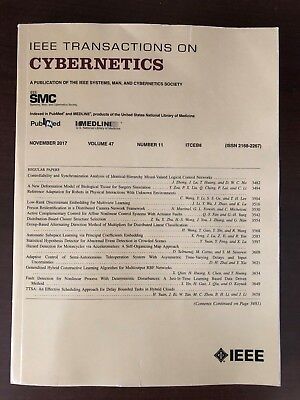Uncalibrated Model-Free Visual Servo Control for Robotic Endoscopic with RCM Constraint Using Neural Networks.
IF 9.4
1区 计算机科学
Q1 AUTOMATION & CONTROL SYSTEMS
引用次数: 0
Abstract
With the advancement of robotic-assisted minimally invasive surgery, visual servo control has become a crucial technique for improving surgical outcomes. However, traditional visual servo methods often rely on precise kinematic models and camera calibration, limiting their generalizability. Considering these, this article proposes a novel uncalibrated model-free visual servo control scheme. Specifically, we introduce a Jacobian matrix and interaction matrix estimation method based on a gradient neural network (GNN), which enables online estimation by utilizing control signals and sensor outputs. Then, the estimated results are incorporated into a visual servo control framework that considers remote center of motion (RCM) constraint, joint-drift problem, and physical constraint, formulated as a quadratic programming (QP) problem. Subsequently, focusing on the joint limits and endoscope insertion depth constraint, we develop a nonpiecewise differentiable multilevel constraint handling technique. For the formulated QP problem, a predefined-time convergent error-regulating zeroing neural network (PTCER-ZNN) solver is designed, and we can derive the optimal control signals. Detailed theoretical analyses of the developed GNN estimation method and the PTCER-ZNN solver are provided. Simulation results demonstrate the effectiveness of the proposed scheme in image feature regulation and tracking tasks, exhibiting its advantages over existing approaches.基于神经网络的RCM约束下机器人内窥镜无标定视觉伺服控制。
随着机器人辅助微创手术技术的发展,视觉伺服控制已成为提高手术效果的关键技术。然而,传统的视觉伺服方法往往依赖于精确的运动学模型和摄像机标定,限制了其通用性。为此,本文提出了一种新的无标定无模型视觉伺服控制方案。具体来说,我们介绍了一种基于梯度神经网络(GNN)的雅可比矩阵和交互矩阵估计方法,该方法可以利用控制信号和传感器输出进行在线估计。然后,将估计结果纳入考虑远程运动中心(RCM)约束、关节漂移问题和物理约束的视觉伺服控制框架,并将其表述为二次规划(QP)问题。随后,针对关节限制和内窥镜插入深度约束,提出了一种非分段可微多级约束处理技术。针对所提出的QP问题,设计了一个预定义时间收敛的纠错调零神经网络(PTCER-ZNN)求解器,并推导出最优控制信号。对所开发的GNN估计方法和PTCER-ZNN求解器进行了详细的理论分析。仿真结果证明了该方法在图像特征调节和跟踪任务中的有效性,显示了其相对于现有方法的优势。
本文章由计算机程序翻译,如有差异,请以英文原文为准。
求助全文
约1分钟内获得全文
求助全文
来源期刊

IEEE Transactions on Cybernetics
COMPUTER SCIENCE, ARTIFICIAL INTELLIGENCE-COMPUTER SCIENCE, CYBERNETICS
CiteScore
25.40
自引率
11.00%
发文量
1869
期刊介绍:
The scope of the IEEE Transactions on Cybernetics includes computational approaches to the field of cybernetics. Specifically, the transactions welcomes papers on communication and control across machines or machine, human, and organizations. The scope includes such areas as computational intelligence, computer vision, neural networks, genetic algorithms, machine learning, fuzzy systems, cognitive systems, decision making, and robotics, to the extent that they contribute to the theme of cybernetics or demonstrate an application of cybernetics principles.
 求助内容:
求助内容: 应助结果提醒方式:
应助结果提醒方式:


